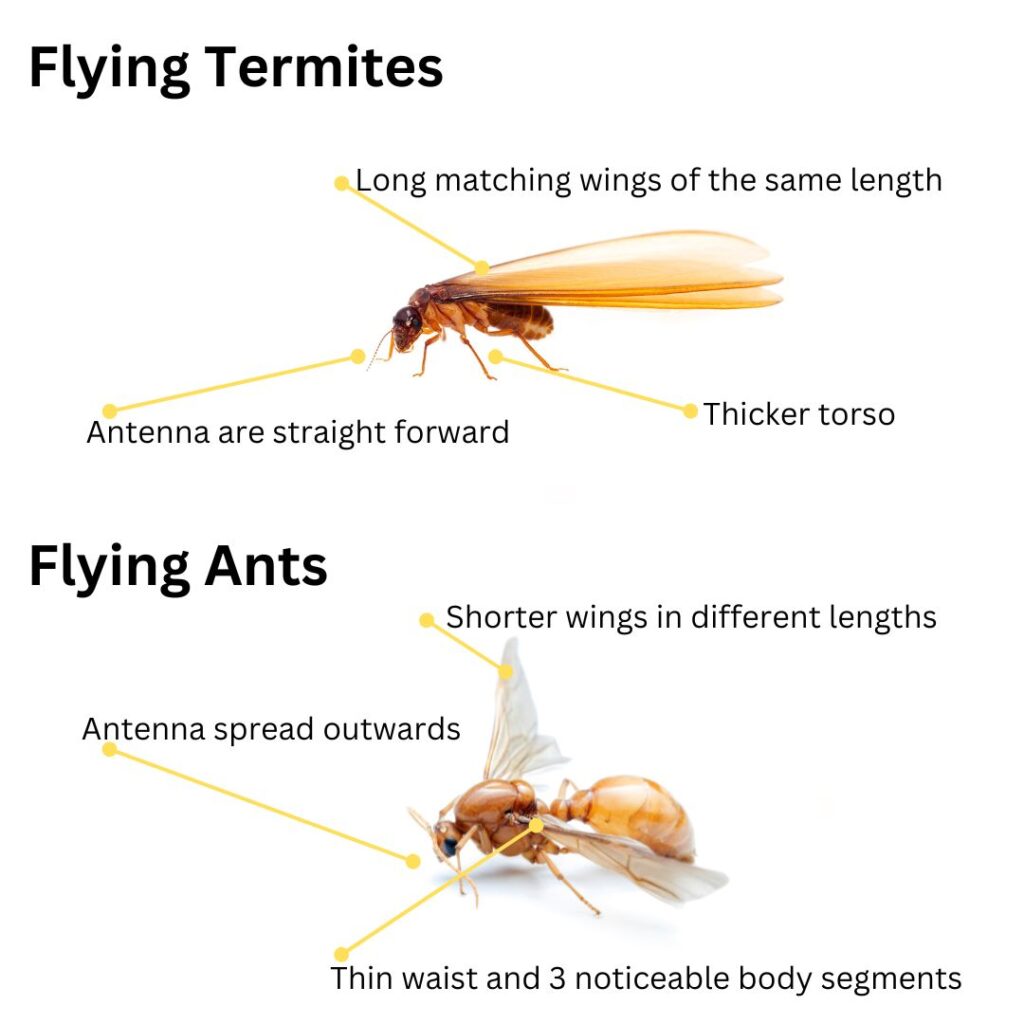Understanding the Phenomenon of Flying Termites
Flying termites, commonly referred to as “swarmers,” typically emerge as seasons shift and humidity increases, especially during the spring and early summer months. During the colder months, these pests remain hidden, silently feeding on wood and expanding their colonies without detection. By the time you notice these swarmers in your home, it’s likely that the termite activity has been ongoing for several months, potentially leading to significant structural concerns. Being aware of their lifecycle and behavior is crucial for effective termite management and prevention strategies.
The combination of high temperatures and subsequent rainfall often triggers massive termite swarms, sometimes consisting of tens of thousands of flying termites. While witnessing such an overwhelming number of swarmers can be unsettling, the likelihood of these termites establishing a new colony in close proximity is relatively minimal. These swarmers are instinctively attracted to light, which explains why they frequently gather around light fixtures in homes. Understanding this behavior can help you remain calm and take appropriate measures to protect your property.
The Hills District, with its lush bushland, offers a stunning living environment that is equally appealing to termites. If you drive along Windsor Road towards Rouse Hill, you can observe numerous termite mounds in the medium strip. This serves as a reminder that the surrounding bushland is teeming with food sources for these pests. Homeowners should remain vigilant, as the proximity to these natural habitats increases the risk of termite infestations within residential properties.
Essential Steps to Take When You Spot Flying Termites
Stay Calm! Your home might not be under immediate termite threat!
Seeing flying termites should serve as a prompt to take protective action rather than a cause for alarm or hasty purchases of expensive termite control systems. Here are several effective steps you can take to ensure your home remains safeguarded against these pests:
- Schedule Regular Inspections: If it’s been some time since your last professional termite inspection, now is the perfect opportunity to arrange one. Annual inspections by a licensed pest control technician are crucial for identifying potential termite issues early on, ultimately saving you from costly repairs.
- Monitor Weather Patterns: Termites are known to swarm on warm, humid nights, making it common to spot them during these favorable conditions. Staying aware of the weather can help you anticipate their activity.
- Accurate Identification: Observe the swarmers closely—do their wings have uniform sizes? Are they flying in a distinct ‘swarm’ or scattering randomly? Are their antennas straight or bent? Is their body shape consistent, or does it taper towards the waist? While flying ants and flying termites may appear similar, their physical characteristics differ significantly, making accurate identification essential.

Crucial Mistakes to Avoid When Dealing with Flying Termites
While the instinct might be to address the issue independently, certain actions could complicate future treatments and exacerbate the problem:
- Refrain from Spraying: Although spraying swarmers may eliminate visible termites, it does not affect the underlying colony and could hinder effective future treatment strategies.
- Avoid Sealing Exit Points: If you notice termites emerging from a hole in your walls, do not seal it off. Blocking their exit can lead to termites burrowing into new areas, potentially increasing the damage to your home.
- Don’t Disturb Mud Trails: If you come across mud tubes or trails, resist the urge to disrupt them. Interfering with these structures can hinder a technician's assessment and compromise their treatment plan.
Assessing the Risk of Termites in Your Home
Seeing flying termites does not necessarily indicate that your home is infested, but it serves as a valuable reminder to remain proactive in your pest management efforts. An annual termite inspection by a qualified professional is your best defense against potential infestations, allowing for early detection and intervention. While preventive measures may appear to be an initial investment, the cost of extensive termite treatment and subsequent repairs can be significantly higher.
Strategies for Effective Termite Protection in Your Home
Committing to regular annual termite inspections is the foundation of an effective pest control strategy. Additionally, following the recommendations of your pest control technician for future prevention can further enhance your protection measures, including:
- Timely refills of your reticulation system to ensure ongoing protection.
- For homes equipped with baiting systems, make sure to schedule regular monitoring with your technician to ensure optimal effectiveness.
- If your property lacks a termite barrier, consider investing in one to enhance your defense against potential infestations.
Timely Action: When to Initiate Termite Treatment
There is no wrong time to start implementing preventive measures, but it’s crucial not to wait until you observe swarmers to take action. By the time flying termites appear, there may already be hidden damage to your property. Initiating preventative steps now can safeguard your home year-round, ensuring your peace of mind.
At So Pest Off, we are dedicated to empowering you with informed, proactive choices regarding termite protection, steering clear of scare tactics.
Contact us for reliable inspections and effective, transparent solutions tailored to your needs.



I find it fascinating how much the environment plays a role in termite behavior. It’s interesting to consider that while we enjoy the emergence of spring with its blooms and warmth, it also signals hidden threats like termites that can wreak havoc on our homes. I recently had a similar experience where I noticed some flying termites in my attic, and it immediately made me think about the potential damage lurking out of sight.
I get what you mean about the duality of spring. It’s such a vibrant time for nature, but it does come with those hidden worries. The presence of flying termites is often a sign that a colony is nearby, and it can feel a bit unsettling to think about what could be happening behind the walls.
You really captured the essence of spring well. It is such a paradox, isn’t it? While we’re all excited to enjoy the blossoms and the fresh air, there’s that underlying tension with nature bringing certain surprises. I’ve had my own run-ins with termites before; I remember when I first noticed them swarming in my attic. It completely shifted my perception of spring from joy to concern.
It’s interesting how spring brings out such a mix of emotions, isn’t it? That contrast between the beauty of nature waking up and the surprises it can spring on us keeps things interesting. Your experience with the termites is a perfect example of that tension. I think a lot of us have had moments where the excitement of the season is dampened by unexpected visitors or challenges.
It’s interesting how you’re linking the beauty of spring to the lurking threats of termites. That contrast really emphasizes how nature operates, doesn’t it? We get to enjoy the warm weather and vibrant blooms, but there’s that underlying knowledge that insects like termites thrive in these conditions.
I found your exploration of flying termites really enlightening! It’s interesting how we often overlook their lifecycle, especially since so much of their activity happens out of sight. I remember when we first discovered a swarm in our backyard, I was taken aback by how quickly they appeared, almost like a scene out of a nature documentary! After that experience, I became more vigilant about checking for signs of termite damage indoors.
Your experience with the swarm in your backyard highlights an important aspect of our relationship with insects that often goes unnoticed. Flying termites, with their sudden appearances, can certainly be a startling event, and it’s fascinating how they can turn any ordinary day into a mini natural spectacle. Many people might dismiss them as just another bug, but their lifecycle is a testament to the complexity of ecosystems that thrive under our noses, often unnoticed until something dramatic happens, like a swarm.
I really appreciate how you highlighted the timing of termite swarms. It’s fascinating—and a bit unsettling—to think about how much activity happens out of sight during the colder months. I remember the first time I noticed those swarmers in my house; it felt like a scene from a horror movie. Thankfully, I started to educate myself on prevention strategies.
It’s intriguing how nature works in ways we often overlook, isn’t it? The hidden lives of termites and the sudden appearance of swarms can definitely send chills down your spine. I remember a similar moment when I first spotted them in my basement too; it felt surreal, almost like an unexpected plot twist in a story.
Your exploration of flying termites, or swarmers, sheds light on a fascinating yet often misunderstood aspect of their life cycle. It’s intriguing to think about how these creatures are often hidden from view, quietly damaging structures while they expand their colonies. This aspect of their behavior raises important questions about our awareness and response to pest management.
It’s true that flying termites, or swarmers, often operate in the shadows, and that can make their impact on our structures quite surprising. I think what adds another layer to this discussion is how we perceive pests in general. Many people regard them with fear or disdain, but these creatures play vital roles in their ecosystems.
Your post provides a great overview of the lifecycle and behavior of flying termites, or swarmers, which is an often-overlooked aspect of home maintenance. I’ve experienced the frustration of discovering termite damage too late, and it truly highlights the importance of proactive inspections, especially as humidity increases during the spring months.
Your post provides a great overview of the lifecycle and behavior of flying termites, or swarmers, which is an often-overlooked aspect of home maintenance. I’ve experienced the frustration of discovering termite damage too late, and it truly highlights the importance of proactive inspections, especially as humidity increases during the spring months.
Your exploration of flying termites and their lifecycle sheds light on an often-overlooked aspect of pest management. It’s interesting how these swarmers, despite their alarming presence, indicate a more extensive and ongoing issue within our homes. I remember a personal experience when we encountered a sudden influx of these termites in our garden, leading us to realize we had undetected damage in our wooden deck. It highlighted the importance of proactive inspection rather than reactive measures.
Your insights into the lifecycle and behavior of flying termites are very enlightening, especially the emphasis on how undetected damage can accumulate over time. It’s fascinating to think about how their swarming behavior is such a strategic part of their reproduction cycle, yet it can catch homeowners completely off guard.
This blog post definitely hits home for a lot of folks, myself included! I can recall the first time I encountered a swarm of flying termites in my own home. It was during a summer gathering, and I remember it felt like an explosion of little wings and confusion just took over our backyard! At the time, I had no idea what they were, and it was both fascinating and terrifying. Thankfully, my neighbor, who happens to be a self-proclaimed “bug expert,” quickly educated me about swarmers and their role in the termite lifecycle.
It’s fascinating to delve into the world of flying termites, or “swarmers,” as you described. Your insights into their lifecycle highlight just how crucial it is for homeowners to be vigilant, especially during the warmer months when these pests are most active. I remember the first time I encountered a flying termite swarm; it was both mesmerizing and concerning. I found myself mesmerized by the sheer number of them, but it also made me acutely aware of their potential impact on the integrity of structures they infest.
It really is fascinating, isn’t it? The lifecycle of flying termites, or swarmers, feels almost magical until you remember the trouble they can bring. Your experience echoes what many feel when they first encounter a swarm—the awe mixed with concern. It’s interesting how nature can be simultaneously beautiful and unnerving.
It’s fascinating how flying termites, or swarmers, serve as a reminder of nature’s cycles and the interconnectedness of our environments. I’ve noticed that their emergence tends to align with our own seasonal rhythms, almost like a natural clock reminding us of the changes in our habitat. It makes you think about the balance between nature and human structures—while we enjoy the warmth and rejuvenation of spring, these little creatures are busy working away, often unnoticed until it’s too late.